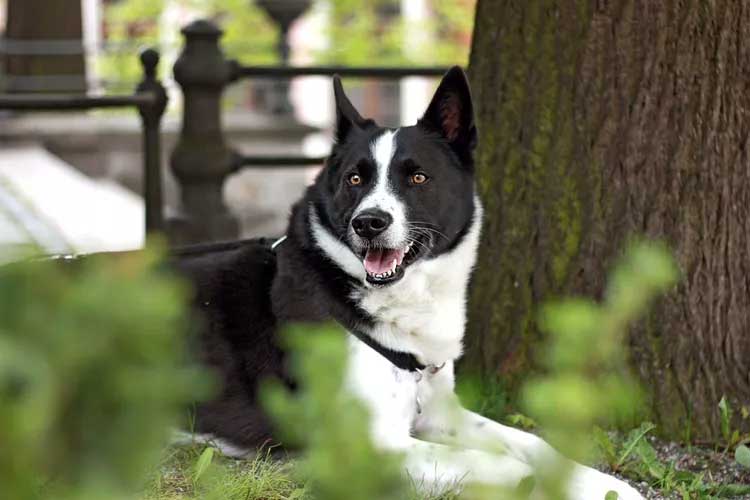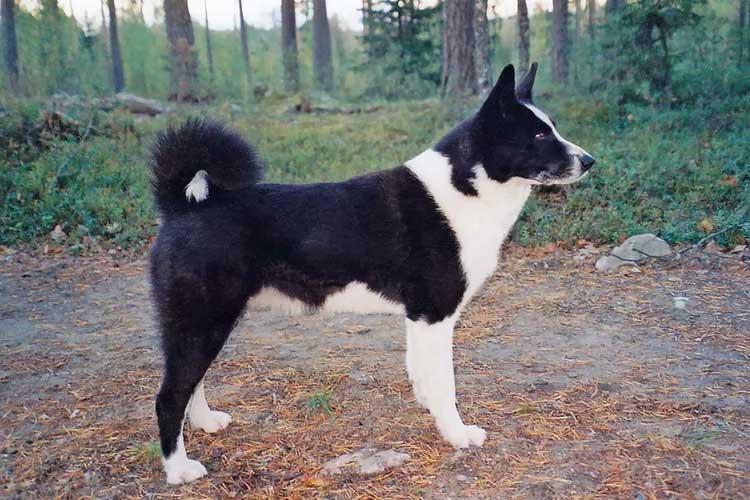A loyal and independent hunting companion, the Karelian bear dog is a rare, medium-sized, Finnish breed that needs a devoted, experienced pet parent—and lots of outdoor exercise.

Karelian Bear Dog Overview
| OFFICIAL NAME | Karelian Bear Dog |
| COMMON NAME | Karelian Bear Dog |
| PET HEIGHT | 19 to 23 inches |
| PET WEIGHT | 37 to 62 pounds |
| LIFESPAN | 11 to 13 years |
| GOOD WITH | families |
| TEMPERAMENT | aloof, willful |
| INTELLIGENCE | high |
| SHEDDING AMOUNT | normal |
| EXERCISE NEEDS | high |
| ENERGY LEVEL | active |
| VOCAL LEVEL | when necessary |
| DROOL AMOUNT | low |
| BREED GROUP | none |
| BREED SIZE | medium (26-60 lbs.) |
| COAT LENGTH | medium |
| COLORS | black, white |
| PATTERNS | bicolor |
| OTHER TRAITS | cold weather tolerant, easy to groom, good hiking companion, high prey drive, loves water, strong loyalty tendencies |
Loyal and intelligent, the rare Karelian bear dog (also known by his Finnish name, karjalankarhukoira) is a medium-sized breed with a black and white coat who's long been prized by big game hunters for his courage, athleticism, and independence. He's not a breed for inexperienced or casual dog owners; his strong hunting instincts and intense need for serious outdoor exercise means he's generally happiest living in the country with an experienced and active owner who can take him hiking or hunting through the woods on a daily basis.
Appearance
With his Finnish origins, it's no surprise that the Karelian bear dog has a dense double coat designed to keep him warm in harsh winter conditions. Even his ears are extra furry to provide protection from frostbite! Although there's a lot of fur, the Karelian is a pretty moderate shedder, and a good weekly brushing should help keep too much fur from flying around your home.
Generally black with white markings, the Karelian's coat can have shades of brown, according to both the American Karelian Bear Dog Alliance's breed standard and the Canadian Kennel Club's. This sturdy, spitz-type breed sports a black nose, brown eyes, high-set erect ears, and high-set tails that may gently curve over the back or may be a bobtail. The typical Karelian bear dog size is 19–23 inches tall, and the dogs typically weigh 37–62 pounds.
This is a seriously striking dog, says Anna Grawbarger, who has had Karelian bear dogs since 1972 when she was a young girl in Finland. She also used to breed them from her current home in Restoule, Ontario.
"Many people love the beauty of the Karelian bear dog and that is what draws people to them initially—I tell people not to let their beauty fool them," she says. There's a lot more to this breed than a pretty face.
Temperament
The Karelian bear dog temperament is unique—and it's the main reason why this breed is not right for every family. With early, consistent training and proper socialization, the Karelian bear dog may learn to get along with other dogs, especially of the opposite sex, but there's no guarantee. These dogs were bred to be tenacious, independent hunters who work alone, and those instincts mean he may be better off as the only pet at home.Now, make no mistake; he can be playful. Still, the confidence, courage, and tenacious spirit that make him such an incredible hunter are the very traits that make him ill-suited for many pet parents.

Dawne Deeley received the Cross of Merit of the Order of the Lion of Finland from the President of Finland in 2005 for her work with Karelians. She has owned, bred, and shown Karelians for over 30 years in British Columbia, is licensed to judge them all over the world, and has been named by the Finnish Kennel Club as the Canadian representative of the breed. Deely puts it bluntly: "For 999 people out of 1,000, this will be the worst dog ever," she says. "But for the other, this is the only dog they'll ever want to live with." As with any breed, the Karelian bear dog can be your perfect pet—if you do your research and know what to expect.
Between his high energy levels and athletic nature, the Karelian needs outdoor activity—and plenty of it—making him an amazing partner for hunters and avid outdoorspeople. "This is a working, hunting dog," Deeley says. "They work solo and weren't created to work in large numbers."
She wants people to understand that, while they bark to alert, Karelian bear dogs were designed for protection; they were bred to hunt game of all sizes, including big moose and bear. Because of this strong prey drive, it's important to always keep your Karelian secure on a leash or in a fenced-in area. "I would never completely trust my males to be running loose," she says. "And [he's] not a dog you'd want to take to the dog park."
When it comes to people, bear dogs are loyal to their families—sometimes to one member in particular. They can be wary of strangers, but typically get along well with humans in general.
"A lot of my dogs have gone into families with kids, and it's been an OK mix," Deeley says. "It's not that Karelians aren't good with kids; it's whether the kids are good with dogs. You need kids—and parents—who are dog savvy." And even with young children who respect and understand how to interact with dogs, supervision is always recommended.
Living Needs
City slickers, apartment dwellers, and weekend warriors should look elsewhere for their perfect match. Karelians need plenty of outdoor exercise, and they need it on the daily. As Deely says, "hiking is job one, and mileage is big.""The ideal place for a [Karelian] would be with a hunter or someone who works in the bush and takes the dog to work with them," Grawbarger says. "The ideal home would be on acreage."
A large yard can be helpful, but be aware that Karelian bear dogs are known escape artists, so you need a fence that's up for the job.
"They require a lot of exercise and are clever to the point of often being difficult to contain," says Maureen Griffin with the American Karelian Bear Dog Alliance. "I had one that untwisted the metal wires that hold the chain link fabric to the frame. I had to replace it with welded, galvanized steel panels used more often for high test military dogs."

Karelians don't tend to get too excited about dog sports like agility, and repetitive games like fetch can leave them bored. But they often enjoy swimming and, as long as they get at least one solid workout session a day (and have acclimated to your home), they're generally great in the house, Deeley says. "They're clean, tidy, not destructive as a rule, and happy to lie in front of a fireplace," she says.
Of course, if they don't get that workout session, Karelian bear dogs may find their own ways to burn off that energy, and you probably won't love the result! However, Deeley says they crate train easily, too.
Care
When it comes to grooming, the bear dog is pretty low-maintenance. Brush him weekly—maybe a little more frequently when his shedding increases seasonally—and bathe him occasionally if he manages to get really dirty while out on his adventures.You'll need to pay close attention to his fast-growing nails, trimming them if you begin to hear them clicking on the floor. Then just brush his teeth regularly, make sure to check his ears for excess wax or debris, and he should be good to go! And remember: The time you spend brushing and looking him over isn't just an opportunity to make sure his fur and skin are in good shape, but it's a great time to bond. So make it a positive experience by offering rewards (like yummy treats) when he allows you to touch his feet, lift his lips, and more.

That positive reinforcement approach is key to training your Karelian in other aspects, too, Deeley says. One of the biggest red flags she sees from people interested in a Karelian bear dog puppy is when they mention dominance-based training. The only real way to work with them is to earn their trust.
"Once you earn their trust, they'll do nearly anything you want," Deeley says. Still, don't forget that Karelians were bred to think for themselves when out hunting. "Understand that this is a really, really independent thinker. And that's not a bad thing!" she says.
Your Karelian bear dog might make choices you don't always like, but if you look at why, you're likely to understand his thinking. "If you want a robotic dog that's always going to do what it's told, get a Malinois," Deeley says. "You don't want this breed."
Health
Karelian bear dog health problems are rare, and the official lifespan is listed as 11-13 years. Deeley notes they're slow to reach their full physical potential, and they're slow to mature mentally, too. "They may look mature physically when they're young, but they keep maturing [mentally] until they're 4–6 years old," she says. "You think they're fully grown at 3, but then, when they turn 5, it's like someone switched dogs."Otherwise, pet parents should be aware of the possibility of hip dysplasia and some eye issues like progressive retinal atrophy and cataracts, according to the breed club. But in general, this is a hardy, healthy breed.
Keep in mind that, because purebred Karelians are so rare—especially in the U.S.—it's unlikely your vet will have seen the breed before. Be sure to communicate closely with your Karelian bear dog breeder to ensure you're fully versed on your dog's health background and can share that information with your veterinarian.
History
This breed might be relatively unknown in the States, but in his home country of Finland he's one of their most-treasured breeds! The Finnish Karelian bear dog originally hails from—you guessed it—Karelia (also spelled Carelia), a province between Finland and Russia. Here, the dogs were relied upon for hunting game of all sizes, although they were particularly prized for their ability to hunt big, aggressive game.That province, now known as the Republic of Karelia, was invaded by Russia during the Winter War at the beginning of World War II. As the people of Karelia evacuated, not all of their dogs were lucky enough to make it out. In fact, after the war, the breed pretty much started over—the Finnish Kennel Club reclaimed 60 dogs and relied on 43 to reinstate the breed, according to the breed club.
And the Finns took the responsibility to promote this breed seriously. "When I started in the breed in 1991, Finland was very strict on where they'd export their dogs," Deeley says. "They wouldn't export them to countries that didn't recognize the breed, like the United States." However, Canada, which has recognized the breed since 1980 through the Canadian Kennel Club and has stricter federal laws on registered breeds, was allowed to bring the dogs in.
Eventually, bear dogs began making their way into other European countries. From there, they began to show up everywhere. However, some Karelian bear dog breeders in the U.S. have crossed the Karelians with other breeds, like the Russo-European Laika, Deeley says. So if you're interested in bringing a Karelian bear dog puppy home, you have some homework to do—and you may end up needing to work with a breeder in Canada or even Finland (where Deeley has gotten her dogs) to get your perfect pup. Otherwise, you could end up with a crossbreed.
Fun Facts
Karelian bear dogs are said to have sisu, a Finnish word that encompasses traits like strength, courage, honor, and perseverance in the face of adversity.The breed nearly went extinct in World War II, and today's Karelians come from just 43 animals, bred under the guidance of the Finnish Kennel Club as they reestablished the breed.
Karelian bear dogs are used by professional handlers in some populated areas of Alaska to humanely locate and deter bears with their barking.